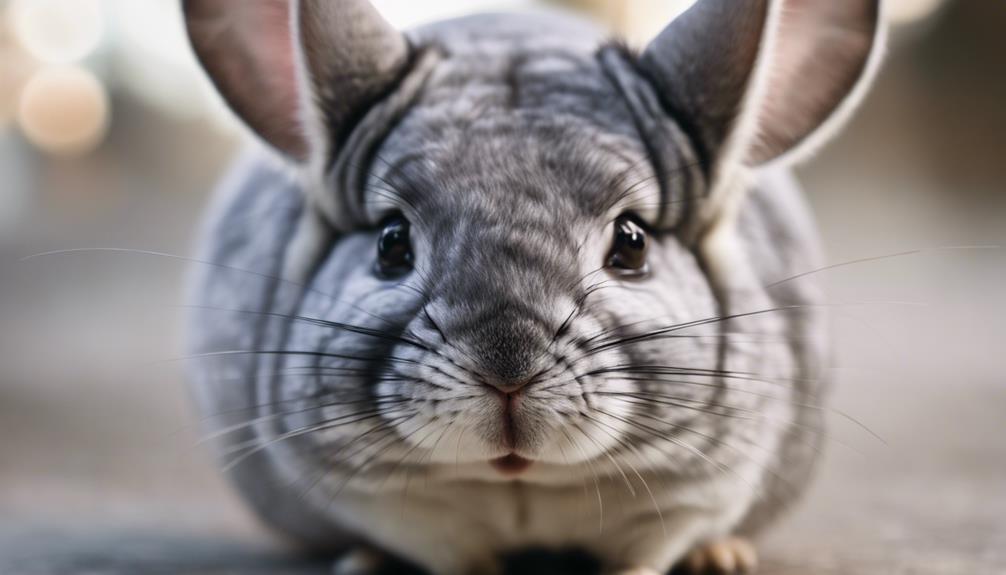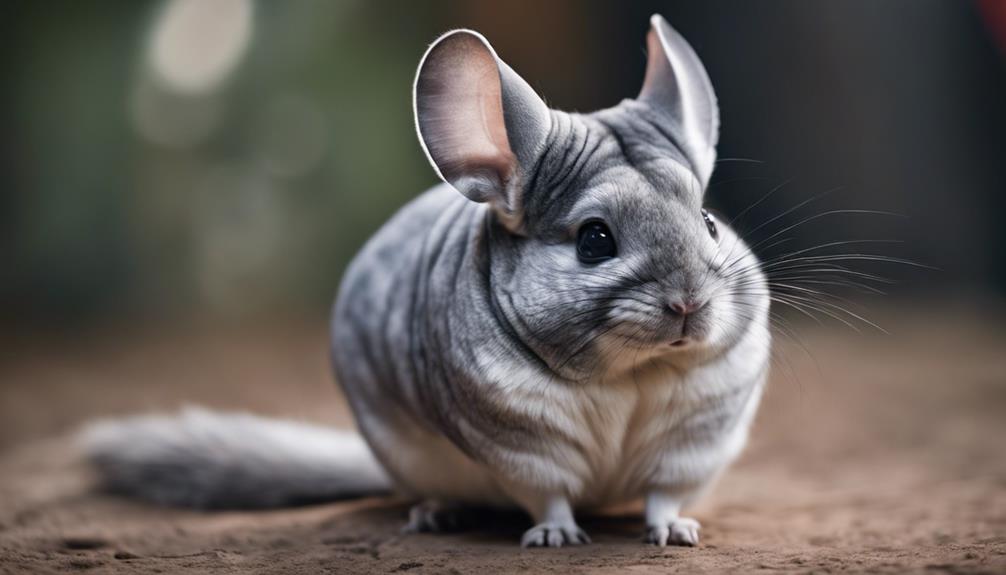When to Consider a Chinchilla's Ear Position in Health Assessment

Chinchillas use their ears to communicate and express emotions. By observing the position of a chinchilla's ears, you can gather valuable information about its health and well-being. Ears that are held upright and facing forward indicate a relaxed and content chinchilla. On the other hand, ears flattened against the head may signal fear, stress, or illness. Regularly monitoring your chinchilla's ear position can help you identify any potential health issues early on. Remember to consult a veterinarian if you notice any concerning changes in your chinchilla's ear position.
Understanding a chinchilla's ear position can provide insights into its overall health and emotional state. By paying attention to the subtle cues conveyed through ear movements, you can better care for your furry companion and ensure its well-being.
Importance of Chinchilla Ear Position
The precise positioning of a chinchilla's ears plays a crucial role in indicating their overall health and well-being. Chinchilla owners and veterinary care providers often use ear position evaluation as a key component of health assessment.
Monitoring the ear position of these small rodents can offer valuable insights into their physical and emotional status. Chinchillas typically hold their ears in an upright and alert position when they're healthy and content. Ears that are drooping or held close to the head may indicate pain, illness, or discomfort.
Regularly observing and noting any changes in ear position can help in the early detection of potential health issues, prompting timely veterinary care interventions. Understanding the nuances of ear position in chinchillas is essential for proactive health management and ensuring the well-being of these furry companions.
Normal Vs. Abnormal Ear Positions

In chinchilla health assessment, distinguishing between normal and abnormal ear positions is crucial for identifying potential issues early on. The ear posture of a chinchilla can provide valuable insights into its overall well-being. Understanding what constitutes normal and abnormal ear positions can aid in prompt veterinary care and prevent any underlying health concerns from escalating.
| Normal Ear Position | Abnormal Ear Position |
|---|---|
| Ears perked up and facing forward | Ears drooping or tilted to the side |
| Ears moving actively in response to sounds | Ears unusually stiff or unresponsive to stimuli |
| Clean and free of discharge or crust | Discharge, redness, or foul odor present |
| Consistent with chinchilla's grooming habits | Ears appearing unkempt or matted with fur |
Regularly monitoring a chinchilla's ear position, in conjunction with other health indicators, can help caretakers intervene promptly if any abnormalities arise. If unsure about a chinchilla's ear posture, consulting a veterinarian for professional guidance is advisable to ensure the chinchilla's well-being.
Behavioral Indicators Through Ear Position

Chinchilla ear position can serve as a window into the animal's emotions, communication style, and overall health.
By observing the subtle nuances in how a chinchilla holds its ears, one can gain insights into its current state of mind and well-being.
Understanding these behavioral indicators through ear position is crucial for interpreting and responding effectively to a chinchilla's needs.
Ear Position and Emotions
Behavioral cues can be inferred through the positioning of a chinchilla's ears, indicating various emotional states. Chinchillas display a range of emotional responses through the movement and angle of their ears, serving as important communication signals.
When assessing a chinchilla's emotions through ear position, consider the following:
- Ears Perked Up: Indicates alertness or curiosity.
- Ears Flattened Back: Suggests fear or aggression.
- Ears Rotating Rapidly: Could signal agitation or excitement.
- One Ear Forward, One Ear Back: May indicate confusion or uncertainty.
Understanding these subtle cues can help caregivers better interpret and respond to their chinchilla's emotional needs.
Ear Position and Communication
When observing a chinchilla, the positioning of their ears serves as key indicators of their communication signals and emotional states.
Chinchillas use their ears to express a wide range of emotions and intentions, making it important to understand these communication cues through body language assessment.
Ears held upright and facing forward typically indicate a chinchilla is alert, engaged, or curious about its surroundings. On the other hand, flattened ears could suggest fear, discomfort, or aggression.
If a chinchilla's ears are constantly twitching or moving rapidly, it might be feeling anxious or stressed.
Ear Position and Health
An observant caregiver can discern a chinchilla's overall health and well-being through careful interpretation of its ear positioning cues. Chinchillas display various behaviors through their ear positions, providing valuable insights into their physical and mental state. When considering a chinchilla's ear position in health assessment, it's crucial to observe how it correlates with grooming habits and sleep patterns.
- Ear position and grooming habits: Chinchillas with ears constantly flattened may be experiencing discomfort or pain, affecting their grooming routine.
- Ear position and sleep patterns: Ears positioned forward during sleep could indicate a state of alertness or anxiety, impacting the quality of rest.
- Ear position and overall activity levels: Monitoring ear movements can help gauge a chinchilla's energy levels and engagement with its surroundings.
- Ear position and social interactions: Chinchillas may use ear positioning to communicate dominance or submission during social interactions within a group.
Ear Position and Pain Signals

Chinchillas communicate discomfort, illness, and behavior through their ear positions. Understanding how their ears are positioned can provide valuable insights into their well-being.
Observing changes in ear position may help caregivers detect potential pain signals early on.
Ear Position and Discomfort
The position of a chinchilla's ears can provide valuable insights into potential discomfort or pain signals they may be experiencing. Chinchillas, like many animals, display various behavioral cues that can indicate their emotional health and well-being. When it comes to ear position and discomfort, keep an eye out for the following indicators:
- Ears flattened against the head: This can signal ear discomfort or pain.
- Ears twitching or constantly moving: It may suggest stress signals or unease.
- Ears drooping or hanging low: This could indicate a chinchilla's emotional distress.
- Ears perked up and alert: A sudden change to this position might indicate a response to external stimuli, showing potential discomfort.
Ear Position and Illness
Observing a chinchilla's ear position can offer valuable insights into potential signs of illness or discomfort, particularly in relation to pain signals. Changes in the way a chinchilla holds its ears may indicate underlying medical conditions that require attention.
For instance, if a chinchilla's ears are drooping or held in an abnormal position, it could be a sign of ear infections, mites, or dental issues that are causing pain. Prompt evaluation by a veterinarian is crucial to diagnose and treat these conditions effectively. Treatment options may include medication for infections, ear cleaning for mites, or dental care to address underlying dental problems.
Maintaining good ear health through regular grooming practices can also help prevent some of these issues.
Ear Position and Behavior
Changes in a chinchilla's ear position can provide valuable insights into its behavior, particularly in relation to pain signals and potential signs of illness or discomfort. Chinchillas communicate through various body language cues, with ear positioning being a key indicator. Here's how ear position can be linked to behavior:
- Ear position and grooming habits: A chinchilla in pain may exhibit changes in ear position during grooming, such as reduced grooming or excessive scratching.
- Ear position and social interactions: Ears held back or flattened against the head could indicate discomfort or fear in social situations.
- Ear position and vocalizations: Combined with specific vocalizations, ear movements can signal distress or discomfort.
- Ear position and feeding behaviors: Abnormal ear positions while eating may suggest dental issues or pain while chewing.
Ear Position as a Stress Indicator

During periods of heightened stress, chinchillas often display noticeable shifts in their ear positioning. Stress levels can significantly impact a chinchilla's behavior, causing them to exhibit specific body language cues that serve as indicators of their emotional state.
Chinchillas communicate their stress through various means, with ear position being a crucial aspect of their non-verbal communication. When a chinchilla is feeling stressed, their ears may flatten against their head or twitch nervously.
These subtle changes in ear positioning can provide valuable insights into the chinchilla's well-being and help caretakers intervene to alleviate the source of stress. Understanding how to interpret a chinchilla's ear position in relation to their stress levels is essential for providing optimal care and ensuring their overall health and happiness.
Ear Position Changes With Illness

Chinchillas experiencing illness may exhibit distinct changes in their ear positioning indicative of their health status. When observing a chinchilla's ear position, it's essential to consider how it may vary with different diseases and health conditions. This can provide valuable insights into the chinchilla's well-being and aid in early detection of potential health issues.
- Ear position and disease progression: The position of a chinchilla's ears can change as an illness progresses, with drooping ears often indicating a worsening condition.
- Behavioral cues and ear position correlations: Chinchillas may display specific behaviors such as reduced activity or appetite, which can be correlated with changes in ear position signaling underlying health issues.
- Ear position and respiratory infections: Respiratory infections can cause a chinchilla's ears to droop or flatten due to discomfort and difficulty in breathing.
- Ear position and dental problems: Dental issues may lead to changes in ear position, as the chinchilla might tilt its head or hold its ears differently to alleviate pain associated with dental problems.
Monitoring Ear Position for Well-being
Regularly monitoring the positioning of a chinchilla's ears is crucial for assessing its overall well-being and detecting potential health issues early on. By staying attuned to ear position awareness, owners can pick up on subtle communication cues that chinchillas use to express their feelings and state of health. Monitoring the health and behavioral changes associated with ear positions can provide valuable insights into a chinchilla's condition and help in timely intervention if needed.
| Ear Position | Indication |
|---|---|
| Upright and Forward | Alertness, Curiosity |
| Flattened Sideways | Fear, Anxiety, Aggression |
| Drooping Backwards | Illness, Pain, Discomfort |
Understanding these ear position signals can aid in promptly addressing issues that may arise in a chinchilla's well-being. By being observant and responsive to changes in ear positioning, owners can ensure a high quality of life for their furry companions.
Frequently Asked Questions
Can a Chinchilla's Ear Position Indicate Their Mood or Emotions?
Chinchillas' ear positions can indicate mood and emotions. Behavioral cues and body language offer insights into their feelings. Understanding these emotional indicators helps interpret chinchillas' communication signs, fostering better interaction and care.
How Can Owners Differentiate Between Normal and Abnormal Ear Positions in Chinchillas?
Chinchilla owners can differentiate between normal and abnormal ear positions by observing their pet's behavior and paying attention to ear anatomy. Health assessment includes monitoring for changes in ear position, which may indicate underlying issues.
Are There Specific Ear Positions That Indicate a Chinchilla Is Experiencing Pain?
In chinchillas, specific ear positions can serve as pain indicators. Owners noticing unusual ear posture should seek veterinary consultation promptly. Early detection and intervention can aid in addressing potential health issues efficiently, ensuring the chinchilla's well-being.
Can a Chinchilla's Ear Position Change Suddenly in Response to Stress or Illness?
Chinchillas may exhibit sudden changes in ear position in response to stress or illness. This behavior can serve as a stress response indicator and offer insight into potential underlying health issues through alterations in body language.
How Frequently Should Owners Monitor Their Chinchilla's Ear Position for Signs of Well-Being?
Frequent monitoring of a chinchilla's ear position is crucial for assessing their well-being. Behavioral changes can indicate health issues. Owners should observe daily, as sudden changes may signal underlying problems requiring prompt veterinary attention.











